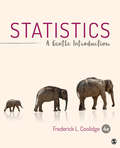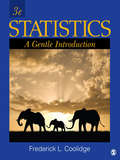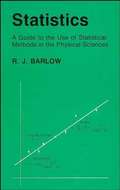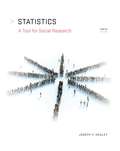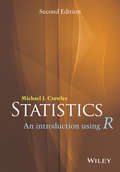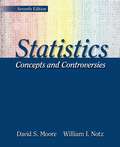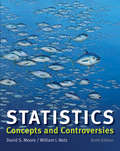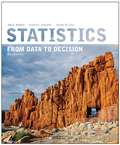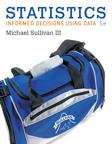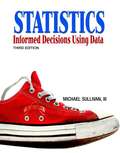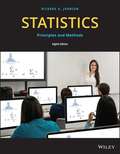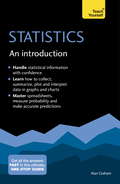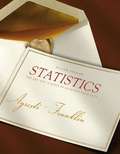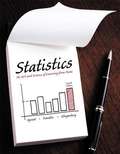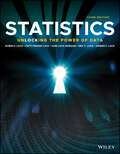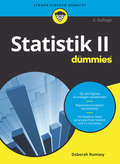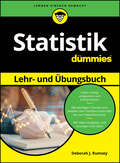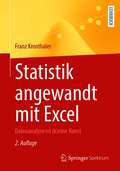- Table View
- List View
Statistics: A Gentle Introduction
by Frederick L. CoolidgeThe Fourth Edition of Statistics: A Gentle Introduction shows students that an introductory statistics class doesn’t need to be difficult or dull. This text minimizes students’ anxieties about math by explaining the concepts of statistics in plain language first, before addressing the math. Each formula within the text has a step-by-step example to demonstrate the calculation so students can follow along. Only those formulas that are important for final calculations are included in the text so students can focus on the concepts, not the numbers. A wealth of real-world examples and applications gives a context for statistics in the real world and how it helps us solve problems and make informed choices. New to the Fourth Edition are sections on working with big data, new coverage of alternative non-parametric tests, beta coefficients, and the "nocebo effect," discussions of p values in the context of research, an expanded discussion of confidence intervals, and more exercises and homework options under the new feature "Test Yourself." Included with this title: The password-protected Instructor Resource Site (formally known as SAGE Edge) offers access to all text-specific resources, including a test bank and editable, chapter-specific PowerPoint® slides.
Statistics: A Gentle Introduction (3rd Edition)
by Frederick L. CoolidgeWith Statistics: A Gentle Introduction, Third Edition, an introductory stats class needn't be difficult or dull! Frederick L. Coolidge specifically designed his text to curtail students' anxieties and minimize unnecessary formulas, while providing a comprehensive review of basic statistical designs and analyses. A wealth of additional real-world examples have been included to give a sense of how the science of statistics works, solves problems, and helps us make informed choices about the world we live in. The author minimizes the use of formulas, but provides a step-by-step approach to their solution, and includes a glossary of key terms, symbols, and definitions at the end of each chapter. Every chapter also includes a short story about historical and contemporary statisticians who figured prominently in the evolution of the discipline of statistics. New to the Third Edition is the thorough incorporation of SPSS throughout, more visual material and figures, and an enhanced treatment of effect sizes, and more detailed explanation of statistical concepts.
Statistics: A Guide to the Use of Statistical Methods in the Physical Sciences (Manchester Physics Series #29)
by R. J. BarlowThe Manchester Physics Series General Editors: D. J. Sandiford; F. Mandl; A. C. Phillips Department of Physics and Astronomy, University of Manchester Properties of Matter B. H. Flowers and E. Mendoza Optics Second Edition F. G. Smith and J. H. Thomson Statistical Physics Second Edition F. Mandl Electromagnetism Second Edition I. S. Grant and W. R. Phillips Statistics R. J. Barlow Solid State Physics Second Edition J. R. Hook and H. E. Hall Quantum Mechanics F. Mandl Particle Physics Second Edition B. R. Martin and G. Shaw The Physics of Stars Second Edition A.C. Phillips Computing for Scientists R. J. Barlow and A. R. Barnett Written by a physicist, Statistics is tailored to the needs of physical scientists, containing and explaining all they need to know. It concentrates on parameter estimation, especially the methods of Least Squares and Maximum Likelihood, but other techniques, such as hypothesis testing, Bayesian statistics and non-parametric methods are also included. Intended for reasonably numerate scientists it contains all the basic formulae, their derivations and applications, together with some more advanced ones. Statistics features: * Comprehensive coverage of the essential techniques physical scientists are likely to need. * A wealth of examples, and problems with their answers. * Flexible structure and organisation allows it to be used as a course text and a reference. * A review of the basics, so that little prior knowledge is required.
Statistics: A Tool For Social Research (Tenth Edition)
by Joseph F. HealeyPacked with everyday examples of statistics in the real world, STATISTICS: A TOOL FOR SOCIAL RESEARCH, 10e, provides a reader-friendly introduction to the fundamental concepts of statistics and their practical application to a wide variety of contemporary social issues. Using myriad examples of statistics from daily life, the text demonstrates that statistics are not just abstract mathematical constructs but have practical value in government, education, business, media, politics, sports, and much more. STATISTICS helps you understand the importance of statistical fundamentals in research without requiring advanced mathematical knowledge. It supports effective learning for both math-averse beginners as well as more advanced students in diverse social science disciplines. Focusing on the application of computational research in favor of the computations themselves, the text fully integrates with the most current version of IBM's SPSS software and labels end-of-chapter SPSS problems by the discipline from which they are drawn. The author breaks down even the most complex material to help you master key concepts and develop the skills you need to succeed as a professional in a social science field-or simply to become a "statistically literate" consumer of social research.
Statistics: An Introduction Using R
by Michael J. Crawley"...I know of no better book of its kind..." (Journal of the Royal Statistical Society, Vol 169 (1), January 2006) A revised and updated edition of this bestselling introductory textbook to statistical analysis using the leading free software package R This new edition of a bestselling title offers a concise introduction to a broad array of statistical methods, at a level that is elementary enough to appeal to a wide range of disciplines. Step-by-step instructions help the non-statistician to fully understand the methodology. The book covers the full range of statistical techniques likely to be needed to analyse the data from research projects, including elementary material like t--tests and chi--squared tests, intermediate methods like regression and analysis of variance, and more advanced techniques like generalized linear modelling. Includes numerous worked examples and exercises within each chapter.
Statistics: Bullet Guides
by Alan GrahamWhat's in this book?Open this book and you will... - Improve communication - Foster development - Establish goals - Encourage successLearn how to be a mentor:- Understanding mentoring- The mentoring process- Successful mentoring relationships- Skills for successful mentors and mentees- Common pitfalls- The benefits of mentoring- Advice about giving advice- Bringing it to a successful closeSample page spread: What are Bullet Guides?The answers you need - now.Clear and concise guides in a portable format. Information is displayed in an easy-to-read layout with helpful images and tables. Bullet Guides include all you need to know about a subject in a nutshell. Get right to the point without wading through loads of unnecessary information.
Statistics: Bullet Guides
by Alan GrahamWhat's in this book?Open this book and you will... - Improve communication - Foster development - Establish goals - Encourage successLearn how to be a mentor:- Understanding mentoring- The mentoring process- Successful mentoring relationships- Skills for successful mentors and mentees- Common pitfalls- The benefits of mentoring- Advice about giving advice- Bringing it to a successful closeSample page spread:What are Bullet Guides?The answers you need - now.Clear and concise guides in a portable format. Information is displayed in an easy-to-read layout with helpful images and tables. Bullet Guides include all you need to know about a subject in a nutshell. Get right to the point without wading through loads of unnecessary information.
Statistics: Concepts And Controversies
by David S. Moore William I. NotzStatistics: Concepts and Controversies (SCC) is a book on statistics as a liberal discipline, that is, as part of the general education of "non-mathematical" students.
Statistics: Concepts and Controversies, Ninth Edition
by David S. Moore William I. NotzDavid Moore and William Notz's Statistics: Concepts and Controversies (SCC) introduces liberal arts majors to statistical ideas--and shows them how use those ideas to think about the statistical claims they see every day from polls, campaigns, advertising, public policy, and many different fields of study. The ultimate goal is to equip students with solid statistical reasoning skills that will help them understand impact of statistics on all aspects of our lives. The new edition offers SCC's signature combination of engaging cases, real-life examples and exercises, helpful pedagogy, rich full-color design, and innovative media learning tools, all significantly updated.
Statistics: From Data to Decision
by Ann E. Watkins George W. Cobb Richard L. ScheafferStatistics, 2nd Edition teaches statistics with a modern, data-analytic approach that uses graphing calculators and statistical software. It allows more emphasis to be put on statistical concepts and data analysis rather than following recipes for calculations. This gives readers a more realistic understanding of both the theoretical and practical applications of statistics, giving them the ability to master the subject.
Statistics: Informed Decisions Using Data Fifth Edition
by Michael SullivanFor courses in introductory statistics. Statistics: Informed Decisions Using Data, Fifth Edition, gives students the tools to see a bigger picture and make informed choices. As a current introductory statistics instructor, Mike Sullivan III presents a text that is filled with ideas and strategies that work in today's classroom. His practical emphasis resonates with students and helps them see that statistics is connected, not only to individual concepts, but also with the world at large.
Statistics: Informed Decisions Using Data Third Edition
by Michael SullivanMichael Sullivan’s Statistics: Informed Decisions Using Data, Third Edition , connects statistical concepts to readers’ lives, helping them to think critically, become informed consumers, and make better decisions. Throughout the book, “Putting It Together” features help readers visualize the relationships among various statistical concepts. This feature extends to the exercises, providing a consistent vision of the bigger picture of statistics.
Statistics: Principles and Methods
by Richard Johnson Gouri BhattacharyyaStatistics: Principles and Methods, 8th Edition provides students and business professionals with a comprehensive introduction to statistics concepts, terminology, and methods with a wide array of practical applications. Real-world data provides an easily relatable frame of reference, while numerous examples reinforce key ideas and demonstrate critical concepts to help ease student comprehension. Designed for those seeking a highly practical introduction to statistical measurement, reasoning, and analysis, this book requires no specific mathematical background and leaves derivations behind in favor of logic, reasoning, and modern statistics software. <P><P>Concepts are introduced first in a real-life setting to illustrate immediate relevancy, and are subsequently expanded to relate underlying mechanisms, limitations, and further applications. An emphasis on the relationship between validity and assumptions underscores the importance of critical thinking and the use of appropriate models while instilling thoughtful habits that lead to accuracy in interpretation. Going beyond the typical introductory text to keep the focus on application, this book gives students a deeper understanding of statistics as it is used every day across disciplines and industries.
Statistics: Teach Yourself
by Alan GrahamDo you need to gain confidence with handling numbers and formulae? Do you want a clear, step-by-step guide to the key concepts and principles of statistics? Nearly all aspects of our lives can be subject to statistical analysis. Statistics: An Introduction shows you how to interpret, analyze and present figures.Assuming minimal knowledge of maths and using examples from a wide variety of everyday contexts, this book makes often complex concepts and techniques easy to get to grips with. This new edition has been fully updated.Whether you want to understand the statistics that you are bombarded with every day or are a student or professional coming to statistics from a wide range of disciplines, Statistics: An Introduction covers it all.
Statistics: The Art and Science of Learning from Data (2nd Edition)
by Alan Agresti Christine FranklinAlan Agresti and Chris Franklin have merged their research and classroom experience to develop this successful introductory statistics text. Statistics: The Art and Science of Learning from Data, Second Edition helps readers become statistically literate by encouraging them to ask and answer interesting statistical questions. It takes the ideas that have turned statistics into a central science in modern life and makes them accessible and engaging to readers without compromising necessary rigor.
Statistics: The Art and Science of Learning from Data (Fourth Edition)
by Alan Agresti Christine Franklin Bernhard KlingenbergThe fourth edition of this textbook aims at improving the student and instructor user experience to learn statistics from the traditional formula-driven mathematical statistics course to a concept-driven approach. This concept-driven approach places more emphasis on why statistics is important in the real world and places less emphasis on mathematical probability. The book aims to help students make the conceptual approach more interesting and more readily accessible.
Statistics: The Easy Way to Learn Stats
by Alan GrahamDo you need to gain confidence with handling numbers and formulae? Do you want a clear, step-by-step guide to the key concepts and principles of statistics? Nearly all aspects of our lives can be subject to statistical analysis. Statistics: An Introduction shows you how to interpret, analyze and present figures.Assuming minimal knowledge of maths and using examples from a wide variety of everyday contexts, this book makes often complex concepts and techniques easy to get to grips with. This new edition has been fully updated.Whether you want to understand the statistics that you are bombarded with every day or are a student or professional coming to statistics from a wide range of disciplines, Statistics: An Introduction covers it all.
Statistics: Unlocking the Power of Data
by Patti Frazer Lock Robin H. Lock Kari Lock Morgan Eric F. Lock Dennis F. LockStatistics: Unlocking the Power of Data, 3rd Edition is designed for an introductory statistics course focusing on data analysis with real-world applications. Students use simulation methods to effectively collect, analyze, and interpret data to draw conclusions. Randomization and bootstrap interval methods introduce the fundamentals of statistical inference, bringing concepts to life through authentically relevant examples. More traditional methods like t-tests, chi-square tests, etc. are introduced after students have developed a strong intuitive understanding of inference through randomization methods. While any popular statistical software package may be used, the authors have created StatKey to perform simulations using data sets and examples from the text. A variety of videos, activities, and a modular chapter on probability are adaptable to many classroom formats and approaches. <P><P><i>Advisory: Bookshare has learned that this book offers only partial accessibility. We have kept it in the collection because it is useful for some of our members. Benetech is actively working on projects to improve accessibility issues such as these.</i>
Statistik
by Hans-Joachim MittagBeim Multimedia-Comenius-Wettbewerb 2011 ausgezeichnet, bietet das Lehrbuch als Kombination aus Druckwerk und interaktiver Online-Fassung eine gelungene Einführung in die Statistik. Das Anwendungsspektrum der Statistik wird anhand aktueller Beispiele illustriert, die statistischen Konzepte in Grafiken visualisiert. Der Band enthält viele Übungsaufgaben mit ausführlichen Lösungen. Die überarbeitete 2. Auflage wird durch neue interaktive Experimente und tongestützte Animationen ergänzt und bietet frei zugängliche Multimedia-Ressourcen im Internet.
Statistik II für Dummies (Für Dummies)
by Deborah J. RumseySie müssen komplexe wissenschaftliche Untersuchungen auswerten? Sie wollen oder müssen dafür Ihren Statistikwerkzeugkasten erweitern? In diesem Buch werden Sie Modelle aufbauen und testen. Sie werden Variablen schätzen, korrelieren und zusammenfassen. Die dabei verwendeten Techniken sind verschiedene Arten der Regression, Varianzanalyse, Chi-Quadrat-Tests und nichtparametrische Prozeduren. Sehr viele Beispiele, teilweise unter Einsatz von SPSS, decken all die verschiedenen Aufgabenstellungen ab, denen Sie begegnen könnten.
Statistik Lehr- und Übungsbuch für Dummies (Für Dummies)
by Deborah J. RumseyIhr praktischer Einstieg in die Statistik Statistik ist nicht immer ganz einfach, aber sehr nützlich. Der Schlüssel zum Erfolg heißt: erst verstehen und dann üben, üben, üben. Deborah Rumsey erklärt Ihnen die notwendigen Grundbegriffe und erläutert die wichtigsten statistischen Konzepte. Dabei kommt sie fast ohne Formeln aus und schafft einen Bezug zwischen Theorie und Praxis. Sie lernen die verschiedenen grafischen Darstellungsmöglichkeiten von statistischem Material kennen und erfahren, wie Sie Ihre Ergebnisse richtig auswerten. Mit Übungen zu allen Themengebieten können Sie dann das erlernte Wissen festigen. Sie erfahren Wie Sie brauchbare Daten erheben Wie Sie Diagramme erstellen und interpretieren Wie Sie mit Wahrscheinlichkeitsmodellen komplizierte Fragen schnell beantworten Wie Sie einen Hypothesentest aufstellen und durchführen
Statistik angewandt mit Excel: Datenanalyse ist (k)eine Kunst
by Franz KronthalerDieses Buch zeigt Ihnen, wie Sie mit Excel beinahe mühelos Informationen aus Daten gewinnen und Datensätze systematisch analysieren können. Beides ist (k)eine Kunst! Die statistischen Methoden werden anhand eines einzigen Datensatzes vorgestellt und diskutiert. So wird deutlich, wie die Methoden aufeinander aufbauen und nach und nach immer mehr Informationen aus den Daten entnommen werden können. Die verwendeten Funktionen von Excel werden dabei ausführlich erklärt – die Vorgehensweise lässt sich daher leicht auf andere Datensätze übertragen. Verschiedene didaktische Elemente erleichtern die Orientierung und das Arbeiten mit dem Buch: An den Checkpoints sind die wichtigsten Aspekte aus jedem Kapitel kurz zusammengefasst. In der Rubrik Freak-Wissen werden weiterführende Aspekte angesprochen, um Lust auf mehr zu machen. Alle Beispiele werden mit Hand und Excel gerechnet. Zahlreiche Anwendungen und Lösungen sowie weitere Datensätze stehen auf der Internetplattform des Autors zur Verfügung. Passende Foliensätze sind für Lehrende auf der Verlagsseite des Buchs abrufbar. Für die zweite Auflage wurde das Buch vollständig auf Excel 2019 umgestellt und aktualisiert. Darüber hinaus wurden Abschnitte zu Preis- und Mengenindizes, Teststärke sowie ein Kapitel zu Varianzanalyse ergänzt.
Statistik angewandt mit dem R Commander: Datenanalyse ist (k)eine Kunst
by Franz KronthalerDieses Buch zeigt IDieses Buch zeigt Ihnen, wie Sie mit dem R Commander beinahe mühelos Informationen aus Daten gewinnen und Datensätze systematisch analysieren können. Beides ist (k)eine Kunst! Die statistischen Methoden werden anhand eines einzigen Datensatzes vorgestellt und diskutiert. So wird deutlich, wie die Methoden aufeinander aufbauen und nach und nach immer mehr Informationen aus den Daten entnommen werden können. Die verwendeten Funktionen von R und dem R Commander werden dabei ausführlich erklärt – die Vorgehensweise lässt sich leicht auf andere Datensätze übertragen. Das Buch liefert somit eine einfache Einführung in eine professionelle und kostenfreie Statistiksoftware.Verschiedene didaktische Elemente erleichtern die Orientierung und das Arbeiten mit dem Buch: An den Checkpoints sind die wichtigsten Aspekte aus jedem Kapitel kurz zusammengefasst. In der Rubrik Freak-Wissen werden weiterführende Aspekte angesprochen, um Lust auf mehr zu machen. Alle Beispiele werden mit Hand und mit R bzw. mit dem R Commander gerechnet. Zahlreiche Anwendungen und Lösungen sowie weitere Datensätze stehen auf der Internetplattform des Autors zur Verfügung. Passende Foliensätze sind für Lehrende auf der Verlagsseite des Buchs abrufbar. Für die zweite Auflage wurde das Buch aktualisiert und ergänzt - etwa um Abschnitte zu ANOVA, Effektstärke, Preis- und Mengenindizes sowie um Übungen, insbesondere solche mit echten Daten.
Statistik für Ausfalldaten
by Gisela HärtlerDieses Buch bietet eine Einführung in die statistische Analyse von Beobachtungs- und Messwerten in Zuverlässigkeitsexperimenten und ist hauptsächlich als Handbuch für den Praktiker gedacht. Leser mit einer technischen Ausbildung, die einen tieferen Einblick in die mathematische Statistik wünschen, finden in diesem Buch eine Anleitung zum Umgang mit empirischer Information und deren Verknüpfung mit statistischen Methoden. Im Vergleich mit anderen Anwendungen der mathematischen Statistik haben Ausfalldaten einige Besonderheiten: Sie sind zeitabhängig, was sich in der Ausfallrate ausdrückt. Die Wahrscheinlichkeit ist gering, dass im Beobachtungszeitraum alle Objekte ausfallen, es entstehen also zensierte Stichproben. Die Ausfallwahrscheinlichkeit im Experiment lässt sich durch Überlastung erhöhen, man muss aber zusätzlich auf die Zuverlässigkeit unter Normbelastung extrapolieren. Für diese Besonderheiten werden spezielle Modelle und Methoden benötigt, die in der Fachliteratur über Statistik sonst nur selten vorkommen.
Statistik für Dummies (Für Dummies)
by Deborah J. RumseyVon A wie Ausreißer bis Z wie Z-Verteilung Entdecken Sie mit Statistik für Dummies Ihren Spaß an der Statistik und werfen Sie einen Blick hinter die Kulissen dieser komplizierten, aber hilfreichen Wissenschaft! Deborah Rumsey zeigt Ihnen das nötige statistische Handwerkszeug wie Stichprobe, Wahrscheinlichkeit, Bias, Median, Durchschnitt und Korrelation. Sie lernen die verschiedenen grafischen Darstellungsmöglichkeiten von statistischem Material kennen und werden über die unterschiedlichen Methoden der Auswertung erstaunt sein. Schärfen Sie mit diesem Buch Ihr Bewusstsein für Zahlen und deren Interpretation, sodass Ihnen keiner mehr etwas vormachen kann!
